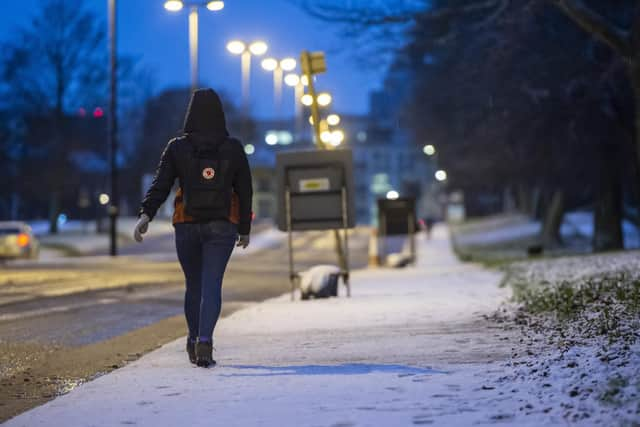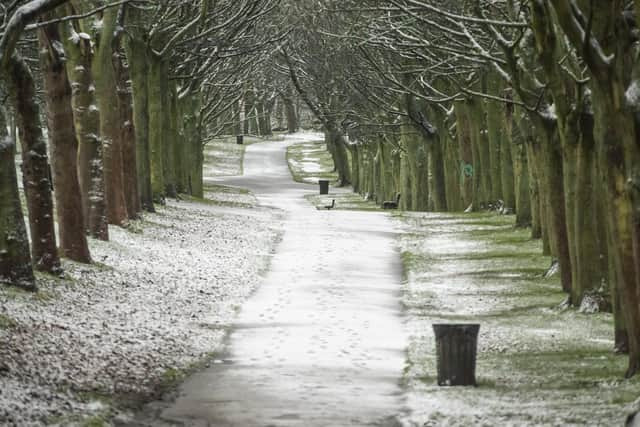Another Met Office weather warning issued for Leeds as snow set to blast city for second day
and live on Freeview channel 276
The Met Office has issued a yellow weather warning for snow in the city, warning of adverse driving conditions and icy surfaces.
The warning is in place from 6pm on Wednesday to 2pm on Thursday.
Advertisement
Hide AdAdvertisement
Hide AdThe forecasters say: "Snow arriving from the north later Wednesday, moving south through Thursday morning may lead to some travel disruption."


Snow is currently forecast for Leeds between 6am to midday on Thursday.
Some roads and railways are likely to be affected with longer journey times by road and delays to bus and train services.
Advertisement
Hide AdAdvertisement
Hide AdIt comes after the city woke up to a blanket of snow on Tuesday morning as temperatures dropped below freezing.


West Yorkshire Police advised drivers to avoid unnecessary travel after a number of crashes in the heavy snow.
Snow and ice brought treacherous conditions to many parts of England overnight, with the cold snap forecast to bite into the new year.
Met Office meteorologist Alex Burkill said the agency lacks a comprehensive ability to measure snow depth and anecdotal reports online of 5cm to 10cm of snow across many parts of the UK were likely to be accurate.
Advertisement
Hide AdAdvertisement
Hide AdHe said there was also a risk of rain turning to ice in North Wales and north-west England overnight into Wednesday as temperatures plunge below freezing.
Temperatures in the afternoon are forecast to be around 4C-7C across the UK, turning cold quickly in the evening with a widespread frost.
Mr Burkill added: “The amount of snow would be disruptive and impactful. We could still see a few centimetres building up. These areas don’t usually see that much snow.”
A low pressure system will see rain meet cold air, turning to snow over hills and lower areas.
Advertisement
Hide AdAdvertisement
Hide AdThe cold snap is forecast to continue well into the new year.
The AA said regional restrictions imposed due to Covid-19 mean roads are quieter than normal.
How to drive safely in snow
- Slow down
Snow, ice and water on the road reduce grip and, coupled with poor visibility in bad weather, they mean it’s essential that you cut your speed.
Stopping distances can be 10 times greater in snow and ice so slowing down gives you more time to react to other traffic or hazards on the road ahead.
Advertisement
Hide AdAdvertisement
Hide AdHowever, be careful that you don’t drive so slowly that you risk losing momentum. On snow-covered roads and especially on hills this could see you stuck and struggling to get moving again.
- Keep it smooth
As well as keeping your speed down you need to keep your inputs smooth. Sharp acceleration, braking or steering are more likely to cause your car to lose grip, leaving you with no control.
Where you can, try to use engine braking to slow down, that way you’re less likely to skid.
- Leave more space
With stopping distances seriously increased by slippy conditions it’s vital you leave more space between your car and the vehicle in front.
Advertisement
Hide AdAdvertisement
Hide AdIt’s also important to try and anticipate what other drivers are doing - being properly aware could save you from a crash or being stranded as others grind to a halt. It also means you're less likely to have to brake or steer suddenly.
- Use a high gear
If your car is struggling to find grip, especially when pulling away, trying selecting a higher gear. This should reduce the amount of wheelspin and help you get moving.
- Stay seen
With shorter days and the prospect of rain, fog or snow making visibility worse, it's important to make sure you can see and be seen. Check all your lights work and are clear of snow or ice before setting off.
Don't wait until it's pitch black to use your headlights and don't just rely on running lights when conditions deteriorate. If it's snowing heavily, dipped beams may actually work better than full beams.
Advertisement
Hide AdAdvertisement
Hide AdSupport the YEP and become a subscriber today. Enjoy unlimited access to local news and the latest on Leeds United, With a digital subscription, you see fewer ads, enjoy faster load times, and get access to exclusive newsletters and content. Click here to subscribe.